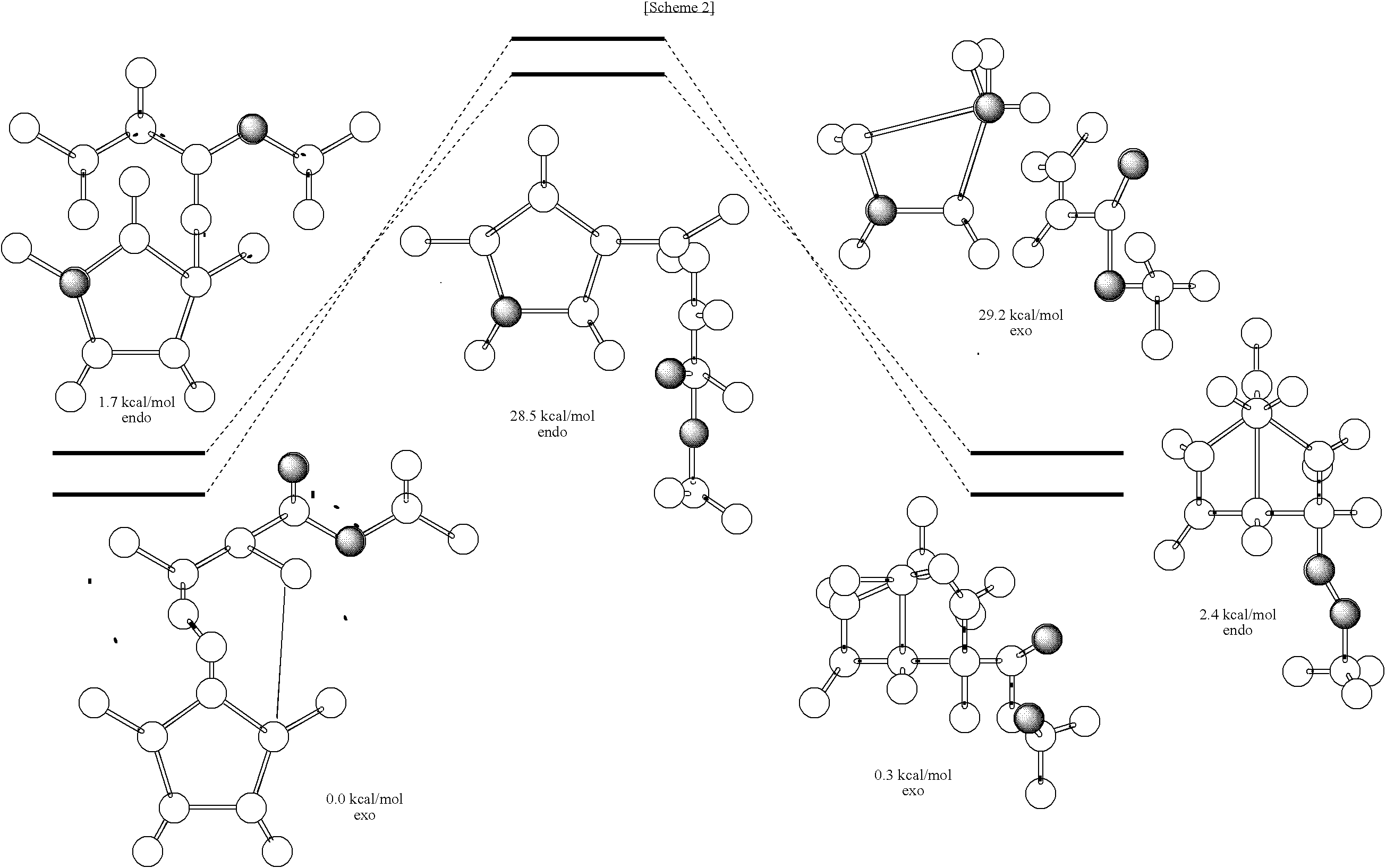Nobonene-ester based addition polymer and method for preparing the same
a technology of addition polymer and norbornene, which is applied in the field of addition polymer of norbornene based monomers, can solve the problems of increasing the dielectric constant, poor dimensional stability, and unsuitable materials for precision optical devices or displays, and achieves low dielectric constant, high glass transition temperature, and low hygroscopicity.
- Summary
- Abstract
- Description
- Claims
- Application Information
AI Technical Summary
Benefits of technology
Problems solved by technology
Method used
Image
Examples
example 1
Preparation of Exo-rich Norbornene Carboxylic Acid Methyl Ester (180° C. 6 Hours, Reaction Quotient=84,993)
[0123]DCPD (Aldrich, 256.5 mL, 1.9 mol), methyl acrylate (Aldrich, 405 mL, 4.5 mol), and hydroquinone (3.2 g, 0.03 mol) were put in a 2 L autoclave. After heating to 180° C., reaction was carried out for 6 hours while stirring the autoclave at 300 rpm. After the reaction was completed, the reaction mixture was cooled down and transferred to a distillation unit. The reaction mixture was distilled at 1 torr using a vacuum pump at 50° C. to obtain the product (yield: 86%). The molar ratio (mol %) of exo / endo isomers of the product was 52:48.
[0124]1H-NMR (600 MHz, CDCl3), endo: δ 6.17 (dd, 1H), 5.91 (dd, 1H), 3.60 (s, 3H), 3.17 (b, 1H), 2.91 (m, 1H), 2.88 (b, 1H), 1.90 (m, 1H), 1.42 (m, 2H), 1.28 (m, 1H); exo: δ 6.09 (m, 2H), 3.67 (s, 3H), 3.01 (b, 1H), 2.88 (b, 1H), 2.20 (m, 1H), 1.88 (m, 1H), 1.51 (d, 1H), 1.34 (m, 2H).
[0125]13C-NMR (600 MHz, CDCl3), endo: δ 29.10 (CH2), 42.39 (C...
example 2
Preparation of Exo-rich Norbornene Carboxylic Acid Butyl Ester (190° C. 5 Hours, Reaction Quotient=89,424)
[0126]DCPD (Aldrich, 180 mL, 1.34 mol), butyl acrylate (Junsei, 500 mL, 3.49 mol), and hydroquinone (2.7 g, 0.025 mol) were put in a 2 L autoclave. After heating to 190° C., reaction was carried out for 5 hours while stirring the autoclave at 300 rpm. After the reaction was completed, the reaction mixture was cooled down and transferred to a distillation unit. The reaction mixture was distilled at 1 torr using a vacuum pump at 80° C. to obtain the product (yield: 78%). The molar ratio (mol %) of exo / endo isomers of the product was 56.2:43.8.
[0127]1H-NMR (600 MHz, CDCl3), endo: δ 6.17 (dd, 1H), 5.86 (dd, 1H), 3.97 (t, 2H), 3.15 (b, 1H), 2.88 (m, 1H), 2.85 (b, 1H), 1.86 (m, 1H), 1.57 (m, 2H), 1.35 (m, 4H), 1.21 (m, 1H), 0.89 (t, 3H); exo: δ 6.09 (m, 2H), 4.05 (t, 2H), 2.98 (b, 1H), 2.86 (b, 1H), 2.20 (m, 1H), 1.88 (m, 1H), 1.58 (m, 2H), 1.50 (d, 1H), 1.34 (m, 4H), 0.89 (t, 3H).
[01...
example 3
Preparation of Exo-rich Norbornene Carboxylic Acid Methyl Ester (200° C. 5 Hours, Reaction Quotient=99,085)
[0132]DCPD (Aldrich, 256.5 mL, 1.9 mol), methyl acrylate (Aldrich, 405 mL, 4.5 mol), and hydroquinone (3.2 g, 0.03 mol) were put in a 2 L autoclave. After heating to 200° C., reaction was carried out for 5 hours while stirring the autoclave at 300 rpm. After the reaction was completed, the reaction mixture was cooled down and transferred to a distillation unit. The reaction mixture was distilled at 1 torr using a vacuum pump at 50° C. to obtain the product (yield: 88.1%). The molar ratio (mol %) of exo / endo isomers of the product was 54.5:45.5.
[0133]1H-NMR (600 MHz, CDCl3), endo: δ 6.17 (dd, 1H), 5.91 (dd, 1H), 3.60 (s, 3H), 3.17 (b, 1H), 2.91 (m, 1H), 2.88 (b, 1H), 1.90 (m, 1H), 1.42 (m, 2H), 1.28 (m, 1H); exo: δ 6.09 (m, 2H), 3.67 (s, 3H), 3.01 (b, 1H), 2.88 (b, 1H), 2.20 (m, 1H), 1.88 (m, 1H), 1.51 (d, 1H), 1.34 (m, 2H).
[0134]13C-NMR (600 MHz, CDCl3), endo: δ 29.10 (CH2), 42...
PUM
| Property | Measurement | Unit |
|---|---|---|
| mol % | aaaaa | aaaaa |
| temperature | aaaaa | aaaaa |
| glass transition temperature | aaaaa | aaaaa |
Abstract
Description
Claims
Application Information
 Login to View More
Login to View More - R&D
- Intellectual Property
- Life Sciences
- Materials
- Tech Scout
- Unparalleled Data Quality
- Higher Quality Content
- 60% Fewer Hallucinations
Browse by: Latest US Patents, China's latest patents, Technical Efficacy Thesaurus, Application Domain, Technology Topic, Popular Technical Reports.
© 2025 PatSnap. All rights reserved.Legal|Privacy policy|Modern Slavery Act Transparency Statement|Sitemap|About US| Contact US: help@patsnap.com



